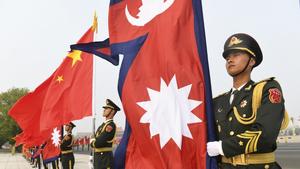 Chinese members of the guard of honour hold Nepalese and Chinese flags ahead of a welcoming ceremony for Nepal's President Bidhya Devi Bhandar at the Great Hall of the People in Beijing on April 29, 2019. (MADOKA IKEGAMI / POOL / AFP)
Chinese members of the guard of honour hold Nepalese and Chinese flags ahead of a welcoming ceremony for Nepal's President Bidhya Devi Bhandar at the Great Hall of the People in Beijing on April 29, 2019. (MADOKA IKEGAMI / POOL / AFP)
People in Nepal are overjoyed to know about the feasibility study conducted by Chinese experts for the 75-km-long Kerung-Kathmandu railway line, with the hope that the much-awaited project will boost bilateral trade, tourism, cooperation and people-to-people exchanges between China and Nepal.
Nepalese believe that the railway project has huge connectivity potential between the two countries and it will have great impact in changing the socio-economic condition of Nepalese as well. They also welcomed China’s decision to open Rasuwagadhi border that was closed for three years due to the COVID-19 pandemic.
“It is our necessity, it is our dream, this is the way to our prosperity,” said Jitender Sharma, a student of Tribhuvan University in Kathmandu.
Railway connectivity and opening of Rasuwagadhi border will help to boost two-way trade and people-to-people exchanges between the two countries, said Shekhar Golchha, a prominent trade and industry representative in Nepal
“The news has excited us. The railway connectivity will create employment opportunities for people of Nepal, said Asish Jha, a trader in New Delhi who hails from Kathmandu.
ALSO READ: Chinese premier congratulates new Nepali PM on inauguration
With the feasibility study, Nepalese can see the final implementation is visible, said representatives of various trade organizations who are happy since Chinese experts have arrived in Kathmandu for the feasibility study last week.
Beginning the feasibility study and opening the Rasuwagadhi border is a double bonanza for the people of Nepal before the new year, said Shekhar Golchha, a prominent trade and industry representative in Nepal.
Railway connectivity and opening of Rasuwagadhi border will help to boost two-way trade and people-to-people exchanges between the two countries, Golchha added.
A day after Nepal’s Prime Minister Pushpa Kamal Dahal assumed office, a six-member Chinese technical team arrived in Kathmandu on Dec 27 to carry out a feasibility study of the Nepal-China cross-border railway.
The China Railway First Survey and Design Institute Group will carry out the feasibility study via a Chinese government grant.
ALSO READ: China, Nepal reaffirm traditional friendship
Because of difficult geological terrain the feasibility study is expected to take around three and half years and it involves laborious engineering workload, said Rohit Kumar Bisural, director general, department of railways of Nepal, adding it is a grand project of China.
“The first batch of Chinese experts have arrived in Kathmandu today to conduct the feasibility study and survey of the China-Nepal cross-border railway,” the Chinese Embassy in Kathmandu said in a statement on Dec 27.
“To conduct the feasibility study and survey of the China-Nepal cross-border railway has been a long-cherished dream of the Nepali people…” the statement said.
“It is also an integral part of jointly building the Belt and Road Initiative between China and Nepal. China gives priority to Nepal’s aspirations and needs in this regard, and will proactively push ahead with the feasibility study with the China aid fund. The two countries will maintain close contact and coordination in jointly carrying out the work ahead with a view of building trans-Himalayan multi-dimensional connectivity network,” it said.
ALSO READ: Intra-party ties cement China-Nepal friendship
The Kerung-Kathmandu railway will be part of the 550-km railroad connecting the Tibetan city of Shigatse with Kerung near the Nepal-China border. Although just 75-km long, construction of the Kerung-Kathmandu section will cost over $3 billion due to difficult geophysical terrains and other complexities, according to the pre-feasibility study report. The plan was formally agreed between China and Nepal in 2017 when Kathmandu joined the BRI.
Nepal’s former Prime Minister KP Sharma Oli signed the agreement for the project during his visit to China in June 2018. A technical assistance agreement was signed by Nepal and China for the project in March this year following the visit of then Chinese Foreign Minister Wang Yi to Kathmandu. Expenses for the feasibility study report and completion of the work on the Chinese side will be borne by the Chinese government, according to the official statement issued by both countries then.
On Dec 28, Beijing opened the Kerung-Rasuwagadhi border, allowing Nepal's exports to pass into China through the border. Khree and halferung-Rasuwagadhi border, a major trade route between the two countries, was shut to two-way traffic for three years, according to the Chinese Embassy in Kathmandu.
PM Dahal on Sunday inaugurated Pokhara Regional International Airport or PRIA in western Nepal. PRIA is a flagship project of Nepal-China BRI cooperation, according to the official Twitter account of the Chinese Embassy in Kathmandu.
READ MORE: Xi says China to continue support for Nepal's virus fight
"Pokhara International Airport has been highly valued by the leaders of China and Nepal. The new airport will become a vivid practice and a powerful witness of working together to achieve common development and prosperity," Chinese Embassy Charge de Affaires in Kathmandu, Wang Xin said on Sunday.
The writer is a freelance journalist for China Daily.


